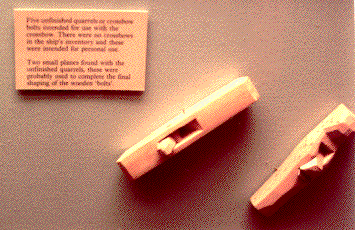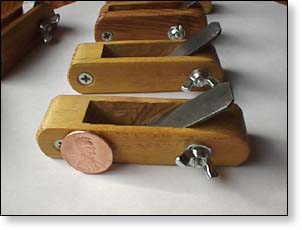
Beavertooth Tools no longer makes arrowplanes for sale via the website.
These are examples of arrowplanes that have been made and sold in the past.
The inspiration for the Arrowplane came from the Mary Rose Exhibit in Portsmouth, England. The Mary Rose, a Henry VIII warship, sank in the English Channel in 1545 and was salvaged in 1982. Among the longbows, arrows and other treasures brought up from the wreck was a woodworkers tool chest and inside the tool chest were two small planes, each with a rounded groove on the bottom. Replicas of these were on display at the Exhibit. The conjecture is that they were used in the making of arrows. The two originals were of traditional plane design which uses a wooden wedge to hold the cutting blade in place. I made up my mind that I HAD to make one when I returned home. The traditional design is quite labor intensive because of the effort needed to get everything to fit properly.


My design is much easier to produce in large quantities. The blade, 1095 carbon steel, has a very hard, sharp edge. Each blade is tested for hardness. If the steel can be scratched by a file then it is rejected. Each blade must be sharp enoiugh to shave the hair on my wrist. In order to re-sharpen the blade I recommend holding it in some sort of fixture which will maintain the correct angle between blade and whetstone. The blade is held in the plane body at an angle of 40 degrees so the bevel on the blade should be from 30 to 35 degrees. Use medium and fine whetstones followed by either a hard Arkansas stone or a Japanesewater stone to get maximum sharpness. In order to prevent rust occasionally wipe the blade with an oily rag.
Making arrows from natural materials, whether sawed or split from
a board or from saplings is a combination of straightening, planing,
rasping, scraping, straightening, planing... There is no one tool
which will do it all. The Arrowplane works best on straight grained
wood. If the grain is not parallel to the surface then you must
plane in the direction which prevents the plane from digging in.
Adjust the depth of cut by loosening the wingnut and sliding the
blade so it is barely visible. Tighten the wingnut and then check
the cut on a piece of scrap. One way of making slight increases
in the depth of the blade is to loosen the wingnut, brace the
plane against a solid surface and then tap the top of the blade
with a small metal hammer.
E-mail your comments to "Richard A. Baugh" at richardbaugh@att.net
We hope the information on the PrimitiveWays website is both instructional and enjoyable. Understand that no warranty or guarantee is included. We expect adults to act responsibly and children to be supervised by a responsible adult. If you use the information on this site to create your own projects or if you try techniques described on PrimitiveWays, behave in accordance with applicable laws, and think about the sustainability of natural resources. Using tools or techniques described on PrimitiveWays can be dangerous with exposure to heavy, sharp or pointed objects, fire, stone tools and hazards present in outdoor settings. Without proper care and caution, or if done incorrectly, there is a risk of property damage, personal injury or even death. So, be advised: Anyone using any information provided on the PrimitiveWays website assumes responsibility for using proper care and caution to protect property, the life, health and safety of himself or herself and all others. He or she expressly assumes all risk of harm or damage to all persons or property proximately caused by the use of this information.
© PrimitiveWays 2013